




























 |
benchtop
bond tester in a handheld package MIZ®-21R Sondicator |
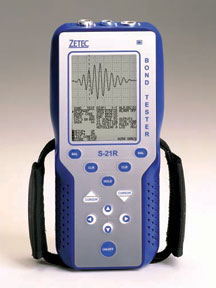 |
| The S-21R offers more power and capabilities than
benchtop bond testers. It incorporates all of the bond testing technology, packaging, and
user interface enhancements of the MIZ-21SR.With much greater sensitivity, it’s more
effective in detecting defects, yet it costs less than benchtop testers. The user
interface makes the S-21R much easier and faster to use than other bond testers.With the
same high-contrast display as the MIZ-21B and MIZ-21SR, it provides excellent visibility.
And at less than four pounds, the S-21R is much smaller than benchtop bond testers, so
inspectors can easily maneuver in limited access areas. It stores up to 40 test
configurations (20 Sondicator mode, 20 Resonance mode) and can operate more than 12 hours
on one battery charge. |
Sondicator technology: A
Sondicator probe uses a dual element piezoelectric transducer to introduce sound waves
into composite materials. One of the transducer elements is a transmitter, the other a
receiver. If the material being inspected is undamaged, the sound waves travel through the
material in a predictable time period. Any disbonds or delaminations within the inspection
zone attenuate the sound waves (and the material vibrations that they create). This
decreases the energy transmitted beyond that point.
The sondicator method provides digital signatures defining normal and abnormal conditions,
displayed as a classic RF waveform format or as an XY screen plot. An experienced
technician can interpret these signatures and determine the location and relative size of
the disbond condition. |
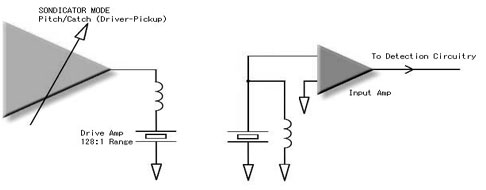 |
You can use the S-21R in the Sondicator mode to test for
disbonds or delaminations in composite and metal-to-metal bonded materials. Or, in the
Resonance mode, it can perform more specific thickness checks, confirming a good sound
path through a section of composite, or identifying which layer is disbonded.
The S-21R’s broad frequency range supports a wide range of applications and probes. |
| Resonance
technology:Closely related to traditional ultrasonic inspection but in a lower
frequency range, this variable frequency test electronically monitors the impedance
changes of the contact transducer’s piezoelectric element. Small variations in the
tested structure alter the mechanical loading (particle vibration) on the transducer face.
This in turn affects the transducer’s electrical impedance. In adhesive bonded
materials,changes in the thickness (caused by disbonds) affect the phase and amplitude of
the signal at the transducer’s resonant frequency. In multi-layered structures, phase
relates to the relative depth of the disbond. |
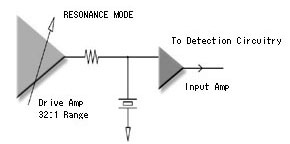 |
| Here's the smallest, lightest, most convenient
way to perform bond testing. The S-21R can do everything a benchtop tester can do, yet it
costs less and is much easier to use. Detect impact damage, disbonds, delaminations, and
other anomalies in honeycomb and composite materials. Improved sensitivity to flaws makes
testing more accurate. Zetec's display technology offers excellent contrast and
resolution. |
 |
The Resonance Sweep display automatically calculates the
resonant frequency of the transducer. This instrument identifies the frequency to within 1
kHz for optimum test sensitivity
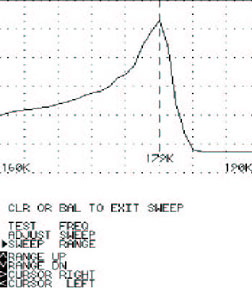 |
Display
Modes
- XY Impedance Plane
- Bar Graph
- YT Sweep
- Combined XY/YT Sweep
Memory Non-volatile (data retained with power off):
- Stores 40 test setups: 20 sondicator and 20 resonance
- Stores 10 screen images for review or comparison
- Stores up to 10 reference points with numeric label in resonance mode
Frequency Selection
- Sondicator mode: 0.5 kHz to 500 kHz (external tuning) or 4 pre-selected frequencies of
7, 14, 25, and 40 kHz (internal tuning)
- Resonance mode: 0.5 kHz to 500 kHz
Filters
- Adjustable high-pass, low-pass, and bandpass filters
- On-screen numeric read-out of cutoff frequency.
Alarms
- Audio alarm with adjustable volume
- Visual LED alarm
- Alarm area is shown on the display; alarm box size and positioning are independently
adjustable
- Alarm triggers either inside or outside of the gated area
- TTL, visual, and adjustable audio output alarms are provided
- Headphone outputs
- Optional probe with LED alarm that lights when user-specified parameters are exceeded
Probe Configuration Internally switches to interface with probe
configurations
Operating Variables
- Burst length in the transmitted pulse is adjustable from 1 to 9 cycles
- Combined transmit drive/preamp gain adjustable over 1 to 128 range
- Analog amplifier gain adjustable over 48 dB (1 to 255 range)
- Optimize the flaw response with adjustable DELAY gate for XY signal set-up
|
The display provides a 60-degree viewing angle.
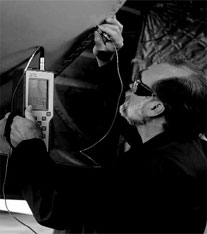 |
Use the YT display for the initial test setup in
Sondicator mode. The sampling gate detects changes in phase and amplitude of the YT signal
and converts this to the XY vector display.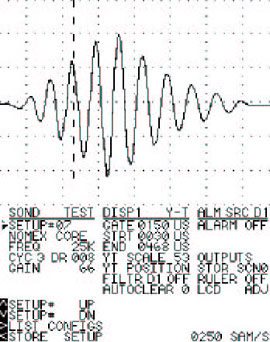 |
|